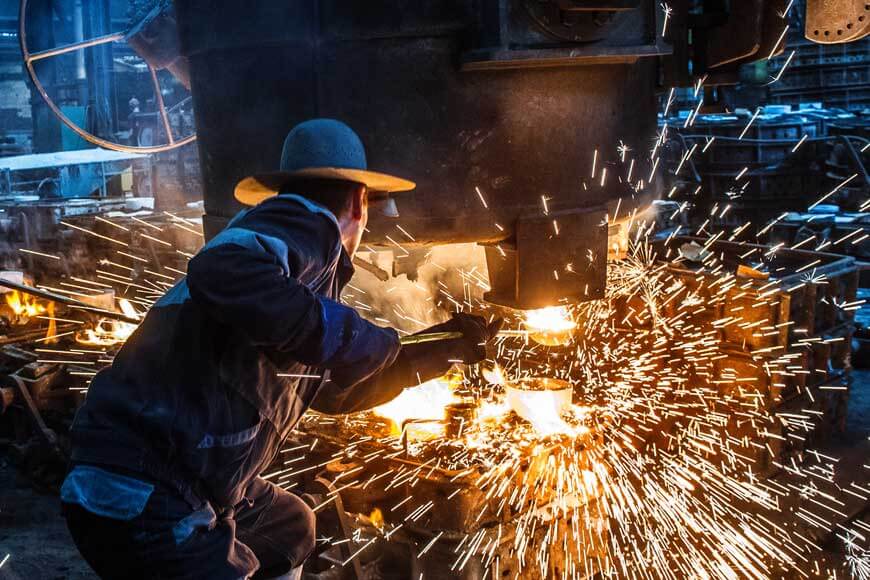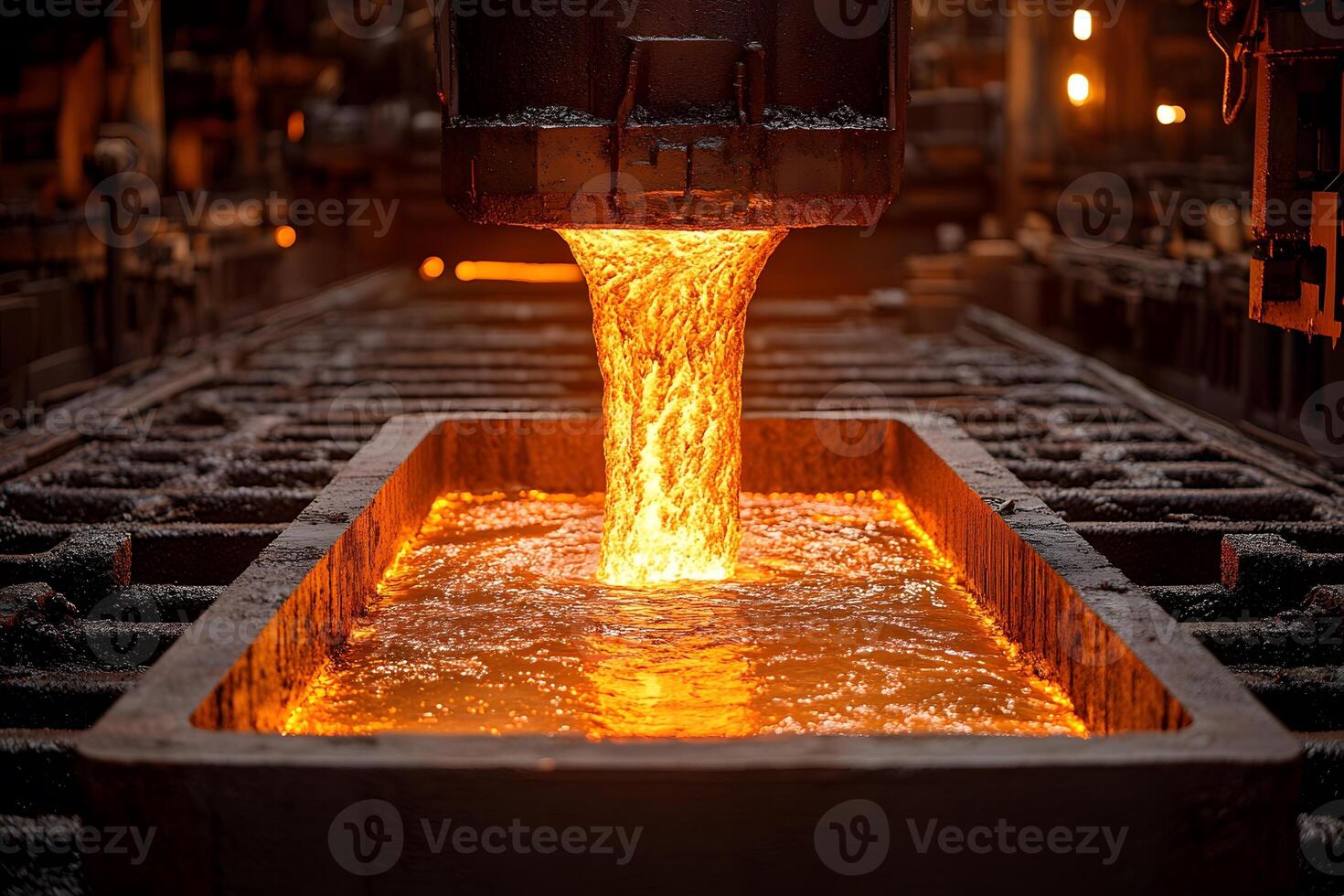How Modern Metal Casting Foundries Are Integrating 3D Printing for Precision
Wiki Article
All Regarding Metal Casting: How Foundries Provide Quality and Precision in Manufacturing
Metal casting stands as a fundamental process in production, where raw metals are transformed right into particular parts. Foundries utilize numerous casting methods to accomplish wanted features and shapes. Each approach includes its very own set of limitations and advantages. Recognizing these nuances is important for valuing just how quality and precision are preserved throughout the procedure. The conversation in advance will explore the complex characteristics of metal casting and its value across several sectors.The Essentials of Metal Casting
Metal casting is a fundamental process in producing that entails forming liquified metal right into desired forms. This important strategy starts with the option of raw materials, frequently different metal alloys, which are melted in a heating system. As soon as the metal gets to the ideal temperature level, it comes to be ready and liquid for casting.The process requires a mold, normally made from sand, metal, or ceramic, which specifies the last shape of the actors item. Once the liquified metal is poured right into the mold, it cools down and solidifies, tackling the mold's contours.
After cooling down, the casting is gotten rid of from the mold and mildew, and any necessary ending up procedures, such as polishing or cutting, are conducted. This method permits suppliers to generate intricate forms and elements with high precision and very little waste. Metal casting is widely utilized throughout various sectors, from vehicle to aerospace, highlighting its importance in modern manufacturing.
Kinds Of Casting Approaches
While numerous casting techniques exist, each technique is and uses distinct advantages matched for different applications. Sand casting, one of the most common approaches, uses sand as the mold and mildew material, permitting large components and complex styles. Investment casting, recognized for its precision, employs a wax pattern covered in ceramic, making it excellent for complicated geometries. Die casting, which entails requiring liquified metal into mold and mildews under high stress, is often used for mass manufacturing of small, thorough components. In addition, shell molding combines sand and resin to develop thinner, much more exact molds, boosting surface coating. Another technique, continuous casting, allows the manufacturing of long sizes of metal shapes, simplifying manufacturing processes. Each of these techniques plays an essential role in the metal casting market, addressing particular demands from production quantity to develop intricacy, therefore adding to the diversity of applications throughout various markets.The Duty of Foundries in Manufacturing
Foundries serve an important feature in the manufacturing landscape, as they change raw steels right into usable elements with numerous casting processes. These facilities utilize an array of strategies to create products that satisfy specific specifications, consequently making certain quality and effectiveness in manufacturing (Metal Casting). By making use of approaches such as sand casting, financial investment casting, and die casting, factories deal with varied sectors, including automotive, aerospace, and building
Eventually, foundries are essential to the production ecosystem, giving important components that sustain a wide range of markets and applications. Their precision and flexibility drive effectiveness in modern-day manufacturing.
Materials Used in Metal Casting
The choice of products utilized in metal casting is essential for accomplishing the wanted homes and efficiency of the end product. Different steels such as bronze, iron, and aluminum are typically utilized, each offering unique benefits. Aluminum is favored for its lightweight and corrosion-resistant top qualities, making it excellent for automotive and aerospace applications. Iron, specifically cast iron, is recognized for its excellent fluidity and strength, appropriate for heavy equipment and framework components. Bronze, with its superior wear resistance, is typically used in aquatic settings.In addition, materials such as silica sand are frequently used for mold making, providing a fine balance between longevity and convenience of shaping. The selection of products likewise includes ingredients like fluxes, which enhance the casting procedure by improving fluidness and lowering oxidation. Ultimately, the appropriate choice of these materials considerably influences the effectiveness and quality of the casting process.
Quality assurance in the Casting Refine
Quality assurance in the casting process is necessary to ensure that final items satisfy market standards and specifications. Numerous examination methods are utilized to determine problems and evaluate the integrity of actors components. Additionally, adherence to established standards and accreditations improves the integrity and efficiency of cast products.Assessment Techniques Employed
Preserving the honesty of actors metal elements relies greatly on various examination methods. Foundries employ aesthetic inspections as an initial measure to recognize surface issues, such as fractures or incorporations. Non-destructive testing (NDT) methods, including ultrasonic screening and radiographic inspection, are crucial for finding internal problems without compromising the part's stability. Dimensional inspections utilizing calipers and coordinate measuring machines confirm that parts meet defined resistances. Additionally, chemical evaluation confirms that the alloy make-up aligns with called for requirements. These inspection methods jointly validate that the castings satisfy the essential quality and efficiency standards, inevitably minimizing the risk of failing in their intended applications. Carrying out these strenuous inspections is fundamental for preserving high criteria in metal casting manufacturing.Specifications and Certifications
Requirements and qualifications play an important function in the quality assurance of the casting procedure. Foundries adhere to different worldwide and industry-specific requirements, such as ISO 9001 and ASTM standards, ensuring uniformity and integrity in their items. These standards outline the required criteria for materials, production techniques, and screening procedures, contributing to a much more effective manufacturing process. Qualifications, such as AS9100 for aerospace applications, even more emphasize the relevance of high quality guarantee in specialized sectors. By getting these qualifications, shops show their commitment to quality, boosting and minimizing problems client contentment. Normal audits and examinations verify compliance, promoting constant enhancement and development within the industry. Inevitably, adherence to developed requirements cultivates depend on between customers and producers.Innovations in Casting Modern Technology

3D Printing Integration
Incorporating 3D printing technology right into metal casting procedures is revolutionizing the manufacturing landscape. This cutting-edge blend enhances the design and production of complicated geometries that typical methods battle to accomplish. By using additive manufacturing for producing molds and cores, factories can substantially reduce preparations and product waste. 3D printing permits for quick prototyping, check out this site making it possible for suppliers to examine layouts quickly and effectively, consequently assisting in iterative improvements. This modern technology additionally sustains the manufacturing of lightweight components, which are vital in markets like aerospace and automobile. Therefore, the assimilation of 3D printing not just enhances operations but additionally boosts the precision and high quality of cast metal items, noting a noteworthy advancement in the sector.Automated Manufacturing Processes
The improvements in 3D printing have led the method for further innovations in computerized manufacturing processes within metal casting. Foundries are increasingly taking on robotics and automation to enhance performance and precision. Automated systems enhance the entire casting workflow, from mold and mildew development to finishing and putting. Smart sensors and real-time surveillance enable for accurate control of temperature levels and material circulation, reducing see here waste and enhancing quality. In addition, software program solutions assist in better layout and simulation, enabling manufacturers to optimize procedures prior to manufacturing begins. These automatic production processes not just decrease labor expenses yet also decrease human error, making certain consistent outcome. Consequently, the integration of sophisticated modern technologies in metal casting is changing manufacturing capabilities and satisfying the expanding needs of different industries.Advanced Material Advancement
As markets require greater efficiency and sustainability, advancements in material development for metal casting are becoming an important emphasis. Engineers and researchers are exploring new alloys and composites that enhance mechanical residential properties while reducing environmental influence. Technologies consist of light-weight materials that maintain stamina, allowing much better fuel efficiency in transport applications. In addition, the unification of recycled products is ending up being a lot more prevalent, aligning with sustainability objectives. Advanced casting methods, such as 3D printing and precision molding, enable the creation of complex geometries that typical approaches can not accomplish. These developments not just enhance the functionality of actors parts yet likewise enhance manufacturing effectiveness. Overall, the continual advancement of product science drives the future of metal casting, fulfilling the demands of modern sectors.
Applications of Metal Casting Across Industries
Metal casting plays a crucial duty in various sectors, as it enables for the manufacturing of intricate forms and high-quality elements with family member performance - Aluminum Foundry. In the automobile industry, cast steels are vital for producing engine blocks, transmission situations, and other crucial parts that need toughness and precision. Aerospace sectors make use of metal casting for components like wind turbine blades and structural aspects, where dependability is paramountAdditionally, equipment and equipment manufacturing take advantage of metal casting by producing gears, housings, and various other intricate components that boost performance. The construction market likewise utilizes metal casting for building attributes, architectural assistances, and installations, showcasing versatility.
Furthermore, the medical area relies upon cast metals for surgical tools and implants, highlighting the need for biocompatibility. In general, metal casting is a foundational process throughout multiple markets, offering options that fulfill strict high quality standards and performance needs.
Frequently Asked Concerns
What Precaution Are Absorbed Metal Casting Foundries?
In metal casting factories, precaution consist of safety gear, ventilation systems, regular equipment upkeep, employee training, and emergency protocols to mitigate dangers connected with heats, hazardous materials, and possible accidents during the casting procedure.How Do Foundries Take Care Of Waste and Environmental Influence?
Foundries manage waste and environmental effect check out this site with recycling materials, implementing purification systems for emissions, and adhering to regulations - Metal Foundry. They additionally take on sustainable practices, such as decreasing power consumption and making use of green compounds in their processesWhat Are the Expenses Associated With Metal Casting Procedures?
The costs related to metal casting processes consist of basic materials, labor, equipment maintenance, energy usage, and waste management. In addition, fluctuations in market value and compliance with environmental guidelines can considerably impact general expenses for factories.How Does Metal Casting Contrast to Various Other Manufacturing Techniques?
Metal casting offers unique benefits, such as intricate shapes and high material performance, compared to techniques like machining or marking. Nonetheless, it may entail longer preparations and higher preliminary prices, depending upon job specs.
What Profession Opportunities Exist in the Metal Casting Market?
The metal casting market provides different career chances, including shop administration, procedure engineering, high quality assurance, mold and mildew design, and device operation. Specialists can likewise pursue functions in study and development, sales, and ecological health and wellness.Metal casting stands as a fundamental procedure in production, where raw metals are changed right into details parts. Metal casting is a fundamental process in manufacturing that includes shaping liquified metal right into wanted types. An additional method, continual casting, allows the manufacturing of lengthy lengths of metal forms, simplifying manufacturing processes. The prices connected with metal casting procedures include raw materials, labor, devices maintenance, power usage, and waste administration. The metal casting sector provides different career chances, including shop monitoring, procedure engineering, quality assurance, mold design, and device procedure.
Report this wiki page